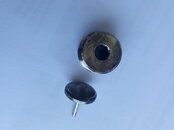awesome-diver
New
Hello
After an ultrasonic bath for 15 minutes with a temperature of 38 degrees the brass parts, valve lifter and spring adjuster, are discolored with black spots. My cleaning solution contains a drop of dishwater detergent and a tiny bit of vinegar concentrate. It seems just to be an optical problem however is it possible to prevent this next time and what are possible causes?
Thank You
After an ultrasonic bath for 15 minutes with a temperature of 38 degrees the brass parts, valve lifter and spring adjuster, are discolored with black spots. My cleaning solution contains a drop of dishwater detergent and a tiny bit of vinegar concentrate. It seems just to be an optical problem however is it possible to prevent this next time and what are possible causes?
Thank You





